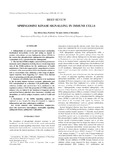Mostrar el registro sencillo del ítem
Sphingosine kinase signalling in immune cells
| dc.rights.license | http://creativecommons.org/licenses/by-nc-sa/3.0/ve/ | |
| dc.contributor.author | Vit Olivier, Patricia | es_VE |
| dc.contributor.author | Melendez, Alirio J. | es_VE |
| dc.contributor.author | Hwee Kee, Tay | es_VE |
| dc.date | 2008-06-17 | es_VE |
| dc.date.accessioned | 2008-06-17T09:00:00Z | |
| dc.date.available | 2008-06-17T09:00:00Z | |
| dc.date.created | 2005-01-01 | es_VE |
| dc.date.issued | 2008-06-17T09:00:00Z | es_VE |
| dc.identifier.other | T016300004836/0 | es_VE |
| dc.identifier.uri | http://www.saber.ula.ve/handle/123456789/16260 | |
| dc.description.abstract | Sphingosine kinase signalling in immune cells (Vit Olivier, Patricia; Melendez, Alirio J. y Hwee Kee, Tay) Abstract 1. Sphingolipids are potent second messengers modulating biochemical intracellular events and acting as ligands to mediate extracellular systems. Sphingosine kinase (SPHK) is the enzyme that phosphorylates sphingosine into sphingosine- 1-phosphate (S1P), a potent bioactive sphingolipid. 2. The fact that SPHK is highly conserved from protozoa to mammals and is ubiquitous in living tissues reveals important roles of the SPHK pathway for the maintenance of health maintenance. This is also supported by comprehensive reviews on features of its main product, S1P, as having intracellular as well as extracellular roles, inducing a wide range of physiological responses from triggering Ca2+ release from internal stores to promoting growth and cell motility. 3. Immune cell activities have been shown to be modulated by the dynamic balance between ceramide, sphingosine and S1P, conceptualized as a rheostat. Cell proliferation, differentiation, motility and survival have been attributed to the regulatory actions of S1P. The properties of SPHK activity in immune cells are linked to the functions of triggered growth and survival factors, phorbol esters, hormones, cytokines and chemokines, as well as antigen receptors, such as Fc y RI and FceRI. 4. Mechanisms of the SPHK signalling pathway are explored as new targets for drug development to suppress inflammation and other pathological conditions. Key words: immune cells, inflammation, lymphocytes, mast cells, monocytes/ macrophages, neutrophils, signalling, sphingosine kinase, sphingosine-1-phosphate. Artículo publicado en Clinical and Experimental Pharmacology and Physiology.(2005) 32, 153-161. | es_VE |
| dc.format.extent | 128579 | es_VE |
| dc.language.iso | es | es_VE |
| dc.publisher | SABER ULA | es_VE |
| dc.rights | info:eu-repo/semantics/openAccess | |
| dc.subject | Biología | es_VE |
| dc.title | Sphingosine kinase signalling in immune cells | es_VE |
| dc.type | info:eu-repo/semantics/article | |
| dc.description.email | vit@ula.ve | es_VE |
| dc.description.tiponivel | Nivel monográfico | es_VE |
| dc.subject.departamento | Departamento de Ciencias de los Alimentos | es_VE |
| dc.subject.facultad | Facultad de Farmacia y Bioanálisis | es_VE |
| dc.subject.keywords | Immune cells | es_VE |
| dc.subject.keywords | Inflammation | es_VE |
| dc.subject.keywords | Lymphocytes | es_VE |
| dc.subject.keywords | Mast cells | es_VE |
| dc.subject.keywords | Monocytes/ macrophages | es_VE |
| dc.subject.keywords | Neutrophils | es_VE |
| dc.subject.keywords | Signalling | es_VE |
| dc.subject.keywords | Sphingosine kinase | es_VE |
| dc.subject.keywords | Sphingosine-1-phosphate | es_VE |
| dc.subject.laboratorio | Laboratorio de Apiterapia y Bioactividad (APIBA) | es_VE |
| dc.subject.tipo | Artículos | es_VE |
Ficheros en el ítem
Este ítem aparece en la(s) siguiente(s) colección(ones)
-
Articulos, Pre-prints (Facultad de Farmacia y Bioanálisis)
-
Articulos, Pre-prints (Laboratorio de Apiterapia y Bioactividad (APIBA))
Articulos, Pre-prints del Laboratorio de Apiterapia y Bioactividad (APIBA)


